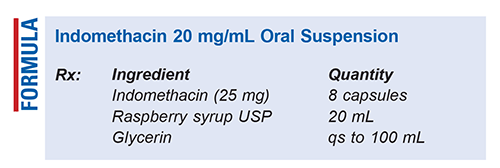US Pharm. 2023;48(3):59-60.

Method of Preparation: Calculate the amount of each ingredient required for the total amount to be prepared. Count out the correct number of capsules, open the capsules, and pour the contents into a mortar. Weigh out the appropriate amount of raspberry syrup; then levigate the powder with a small amount of syrup until a smooth paste is formed. Add the remaining syrup to form a liquid; then transfer the contents to a calibrated bottle. Rinse the mortar with glycerin; then bring the final volume to 100 mL with glycerin. Shake vigorously until the powder is evenly suspended.
Use: Indomethacin oral suspension has been used to treat various forms of moderate-to-severe arthritis.
Packaging: Package in a tight, light-resistant container. Store at controlled room temperature.
Labeling: Keep out of reach of children. Keep refrigerated. Protect from light. Shake well. Discard after ____ [time period].
Stability: The USP default beyond-use date for nonpreserved aqueous oral liquids is 14 days when stored in a refrigerator.1
Quality Control: Quality-control assessments include weight/volume, pH, specific gravity, active drug assay, color, rheologic properties/pourability, physical observation, and physical stability (discoloration, foreign materials, gas formation, mold growth).2
Discussion: Indomethacin, a nonsteroidal anti-inflammatory drug (NSAID) with analgesic and antipyretic properties, is a potent inhibitor of the synthesis of prostaglandins, which are inflammatory mediators. Indomethacin is approved to treat moderate-to-severe osteoarthritis, rheumatoid arthritis (including acute flares), ankylosing spondylitis, acute gouty arthritis, and acute painful shoulder (bursitis or tendinitis). The most common adverse effects of indomethacin are dizziness, headache, dyspepsia, and nausea.3 Indomethacin is contraindicated in patients with known hypersensitivity to the components of indomethacin; those with a history of asthma, urticaria, or other allergic reactions to NSAIDs; and those undergoing coronary artery bypass graft surgery. In general, the use of NSAIDs increases the risk of serious cardiovascular thrombotic events and gastrointestinal adverse effects.3
Indomethacin (C19H16ClNO4, MW 357.8) is a white to yellow, crystalline powder that is only slightly soluble in alcohol. Indomethacin has a pKa of 4.5 and is stable in neutral or slightly acidic media; however, it decomposes in strong alkali media.3 At room temperature, indomethacin has a half-life of approximately 200 hours in a pH 8.0 buffer and a half-life of around 90 minutes in solutions of pH 10. Each capsule contains 25 mg of indomethacin. The inactive ingredients in each indomethacin capsule include colloidal silicon dioxide, FD&C Blue No. 1, FD&C Red No. 3, gelatin, lactose, lecithin, magnesium stearate, and titanium dioxide.3
Raspberry syrup USP is a sweet, viscous, sucrose-based solution containing 48% v/v raspberry juice, alcohol, and purified water. Sucrose (C12H22O11, MW 342.30) is a white, crystalline powder or a colorless, odorless crystal; it is a sugar derived from sugarcane and other sources. It is practically insoluble in chloroform and 1 in 0.5 soluble in water at 20°C. Sucrose has a high degree of stability at room temperature. Sucrose syrup (50%-67% w/w sucrose) is used as a tablet-coating agent for oral preparations as well as a vehicle in oral liquid dosage forms. In this oral suspension, the syrup also acts as a flavoring agent.4
Glycerin (C3H8O3, MW 92.09) is an odorless, clear liquid with a sweet taste that is 0.6 times sweeter than sucrose. It is 95% soluble in ethanol, methanol, and water but is virtually insoluble in benzene, chloroform, and oils. Glycerin is hygroscopic and should be stored in an airtight container in a cool, dry environment. It may crystallize if stored at low temperatures. Glycerin is an antimicrobial preservative, emollient, humectant, plasticizer, solvent, and a sweetening and tonicity agent. The applications of these properties differ depending on the formulation in which glycerin is used. In topical formulations, glycerin functions as a humectant and emollient, since it draws in moisture and keeps surfaces moist; in oral solutions, glycerin is used as an antimicrobial preservative and as a sweetening agent.5
REFERENCES
1. U.S. Pharmacopeia/National Formulary [current revision]. Rockville, MD: U.S. Pharmacopeial Convention, Inc; September 2022.
2. Allen LV Jr. Standard operating procedure for performing physical quality assessment of oral and topical liquids. IJPC. 1999;3:146-147.
3. Indocin (indomethacin capsules) product information. Philadelphia, PA: Iroko Pharmaceuticals, LLC; March 2019.
4. Sucrose. In: Rowe RC, Sheskey PJ, Owen SC, eds. Handbook of Pharmaceutical Excipients. 5th ed. Washington, DC: American Pharmacists Association; 2006:744-747.
5. Glycerin. In: Rowe RC, Sheskey PJ, Owen SC, eds. Handbook of Pharmaceutical Excipients. 5th ed. Washington, DC: American Pharmacists Association; 2006:301-303.
The content contained in this article is for informational purposes only. The content is not intended to be a substitute for professional advice. Reliance on any information provided in this article is solely at your own risk.
To comment on this article, contact rdavidson@uspharmacist.com.





